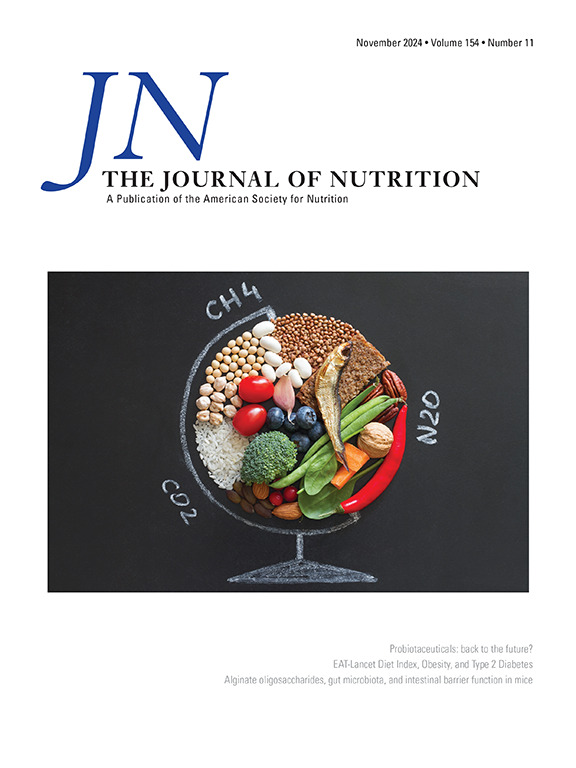Effects of Ferric Carboxymaltose on Pica among Pregnant Women in Malawi: A Substudy to a Randomized Controlled Trial
IF 3.7
3区 医学
Q2 NUTRITION & DIETETICS
引用次数: 0
Abstract
Background
Pica is the craving and consumption of nonfood items, and includes the ingestion of earth, raw starch, and ice. Pica is common in sub-Saharan Africa, especially during pregnancy. Despite being ubiquitous, its etiology is not well understood.
Objectives
We leveraged the randomized trial of intravenous iron for anemia in Malawian pregnant women (REVAMP) to determine the effects of iron therapy, compared with standard-of-care oral iron, on pica among anemic pregnant women.
Methods
REVAMP was an open-label, individually randomized controlled trial, conducted in Malawi. A total of 862 pregnant anemic women in their second trimester were randomly assigned at baseline to receive either 1) a single dose of ferric carboxymaltose (FCM) or 2) standard-of-care oral iron. Pica was assessed at baseline and 4 wk postrandomization by asking participants whether they had craved and consumed earth (geophagy), unripe mango (amylophagy), raw rice (amylophagy), ice (pagophagy), ash, charcoal, or chalk in the past 2 wk. Venous blood was collected for hemoglobin and ferritin concentrations. A longitudinal Poisson model was used to examine the treatment effect of FCM on overall pica and types of pica.
Results
At baseline, the prevalence of any pica was 71.7%, and geophagy was 31.9%. Hemoglobin and ferritin concentrations improved following FCM compared with standard-of-care oral iron and were lower among participants with geophagy. From baseline to 4 wk post randomization, the prevalence of geophagy decreased more among women assigned to FCM compared with standard of care [FCM: 33.5%–12.9%, standard of care: 30.4%–22.3%, prevalence ratio (PR) = 0.53 (95% confidence interval: 0.39, 0.72), P < 0.0001]. There was no evidence of a treatment effect for overall pica [FCM: 70.7%–57.3%, standard of care: 72.6%–63.0%, PR = 0.93 (0.83, 1.06)], amylophagy, or pagophagy.
Conclusions
This study provides causal evidence that geophagy is reduced by improvements in iron status and anemia during pregnancy.
Trial registration number
This trial was registered at www.anzctr.org.au as ACTRN12618001268235.
羧基麦芽糖铁对马拉维孕妇异食癖的影响:一项随机对照试验的子研究。
背景:异食癖是对非食物的渴望和消耗,包括对泥土、生淀粉和冰的摄入。异食癖在撒哈拉以南非洲很常见,尤其是在怀孕期间。尽管无处不在,但其病因尚不清楚。目的:我们利用马拉维孕妇静脉注射铁治疗贫血的随机试验(REVAMP)来确定铁治疗与标准护理口服铁相比对贫血孕妇异食癖的影响。方法:REVAMP是一项开放标签、单独随机对照试验,在马拉维进行。共有862名妊娠中期贫血妇女在基线时随机接受1)单剂量羧麦糖铁(FCM)或2)标准护理口服铁。在基线和随机化后4周评估异食癖,询问参与者在过去两周内是否渴望和食用泥土(食土)、未成熟的芒果(噬淀粉)、生大米(噬淀粉)、冰(噬淀粉)、灰烬、木炭或粉笔。采集静脉血检测血红蛋白和铁蛋白浓度。采用纵向泊松模型检验FCM对整体异食癖和异食癖类型的治疗效果。结果:基线时,异食癖的患病率为71.7%,食土癖的患病率为31.9%。与标准护理口服铁相比,FCM后血红蛋白和铁蛋白浓度有所改善,食土患者的血红蛋白和铁蛋白浓度较低。从基线到随机分组后4周,与标准护理组相比,FCM组的食土率下降更多(FCM: 33.5%至12.9%,标准护理组:30.4%至22.3%,患病率(PR) =0.53 [95% CI 0.39-0.72]。结论:本研究提供了因果证据,表明妊娠期间铁状态和贫血的改善减少了食土。试验注册号:ACTRN12618001268235。
本文章由计算机程序翻译,如有差异,请以英文原文为准。
求助全文
约1分钟内获得全文
求助全文
来源期刊

Journal of Nutrition
医学-营养学
CiteScore
7.60
自引率
4.80%
发文量
260
审稿时长
39 days
期刊介绍:
The Journal of Nutrition (JN/J Nutr) publishes peer-reviewed original research papers covering all aspects of experimental nutrition in humans and other animal species; special articles such as reviews and biographies of prominent nutrition scientists; and issues, opinions, and commentaries on controversial issues in nutrition. Supplements are frequently published to provide extended discussion of topics of special interest.
 求助内容:
求助内容: 应助结果提醒方式:
应助结果提醒方式:


